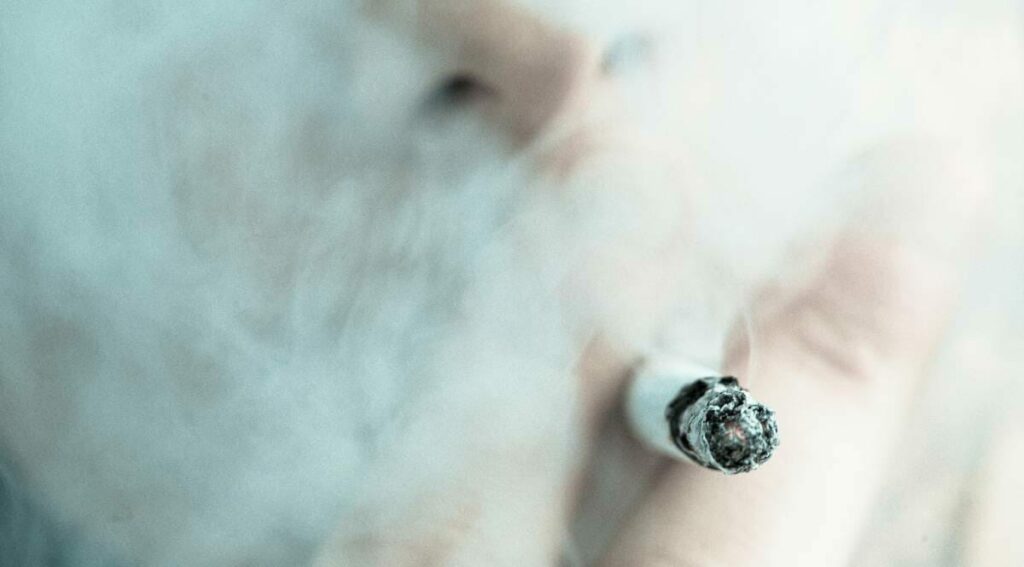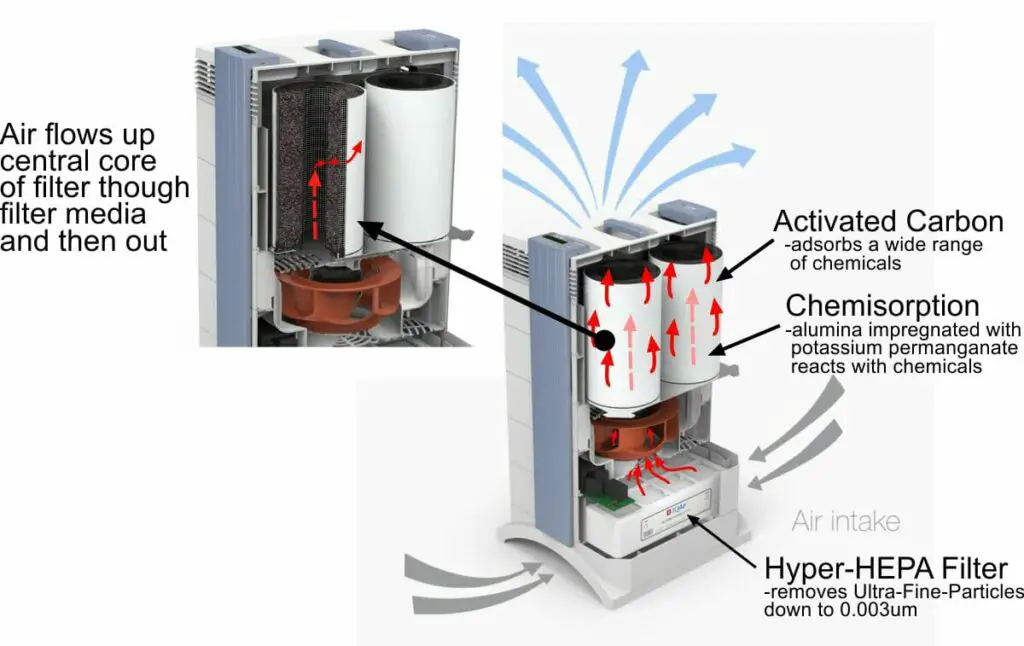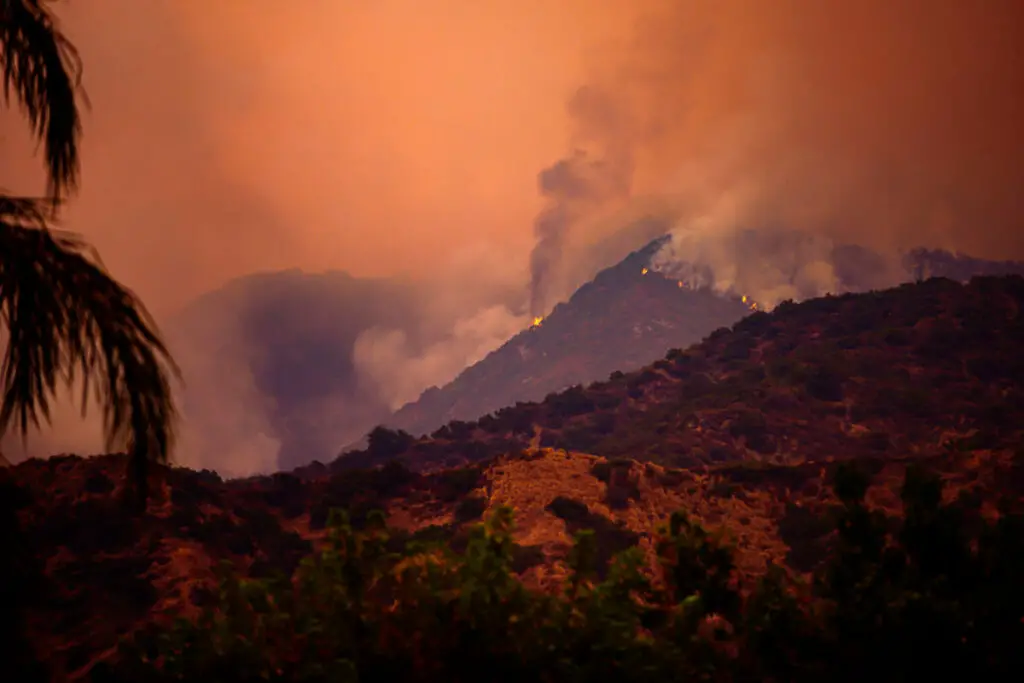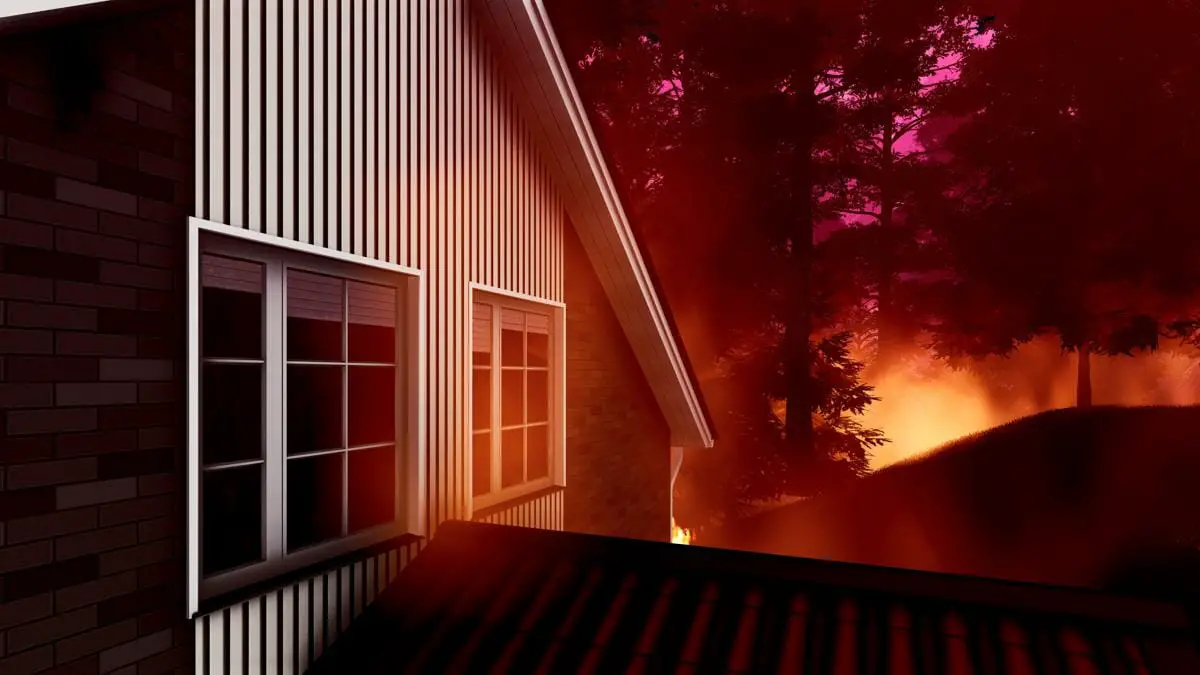We all know to avoid smoke for the sake of our health. Smoke is particularly toxic to human health because it not only contains particle pollution but also chemical pollution. So it is not surprising that wildfire smoke has twice the impact on respiratory health compared to particles from other sources. We cannot avoid wildfire smoke and smoke pollution in communities where wood is burnt for heating. Nor can we avoid the burning of hydrocarbons by power plants, common in the eastern USA. It also applies to secondhand smoke from the cigarettes of a family member.
Although we cannot always avoid the source of the smoke, it is still possible to have very high air quality indoor air. This can be achieved very effectively by using the right air purifier.
Smoke contains potentially cancer causing chemicals so an air purifier to deal with smoke should have excellent chemical removal properties. The best air purifier for smoke is the iQair MultiGas for rooms up to 195 sq ft. For larger rooms the Coway 400S is best.
So how to work out which air purifiers are best? The choice of the best air purifier is governed by how air purifiers work and the particular features of smoke-

The basics of any effective air purifier is a housing with a fan blowing air through a true HEPA filter. A HEPA filter is made of a fine mesh of fibreglass and polymer fibers. This mesh has tiny holes and particles larger than the size of the holes become trapped. It also has several other mechanisms for trapping particles such as-
- inertial impaction
- interception
- diffusion
- electrostatic attraction
If you are interested how a HEPA filter works is explained in this article. So HEPA filtration easily removes particulate matter such as mold spores, dust mites, pet dander and allergen such as pollen. These are all either fine or coarse particles.
However, at the other end of the spectrum obviously single molecules will go straight through the small holes in a HEPA filter, so a HEPA filtration system is no good for removing gaseous pollutants. In between the relatively large size of fine and coarse particles and the incredibly tiny molecules lie a group of particles called ultrafine particles. These are particles less than 0.1um to the size of molecules.
Unfortunately the HEPA standard and AHAM testing only measures the removal of fine and coarse particles, not ultrafine particles. Ultrafine particles enter deep into our lungs and in the terminal air sacs, the alveoli, where gas enters the blood ultrafine particles enter our bloodstream. They have been found in human brains and are probably responsible for many of the adverse health effects of air pollution. Ultrafine particles comprise more than 90% of the particles in the air and cannot be measured by normal air quality sensors.
Particular Features of Smoke Air Pollution That Dictate Which Air Purifiers Are Best
So in choosing an air purifier for smoke we need to consider the 2 particular challenges that smoke presents-
- type of airborne particles, particularly ultrafine particles
- chemicals in the smoke.
Smoke contains a significant amount of ultrafine particles that we need to remove
If so, this would help us quickly narrow down the choice of HEPA air purifier as only 3 manufacturer’s specify their air purifiers for the removal of ultrafine particles.
Cigarette Smoke
Although tobacco smoke particles are typically 0.1 to 0.7 microns in diameter, according to this study. Another study suggested that cigarette smoke does contain sufficient ULF particles to damage health and found that levels of ULF approximately halved with the introduction of a smoking ban in bars and restaurants in Italy.
So what about wildfire smoke?
Both fine and ultrafine particles are produced by wildfires. Also there are tarball aggregates in wildfire smoke. In fact these are 10 times more common than soot particles. There are a significant number of tar balls in wildfire smoke in the less than 0.1um range, the ultrafine range.
So to deal with smoke particles it would be wise to have an air purifier that is specified to deal with ultrafine particles. This narrows the choice to just 3 manufacturer’s-so we are close to choosing our machine!
To be fair to other manufacturer’s their machines may catch ultrafine particles but they do not give us any data or certify that they do.
Smoke contain very harmful chemicals such that need removing
Although particles are the usual pollutants that cause health effects, smoke is particularly damaging as it contains a significant concentration of chemicals. These are known as “gas-phase hazardous air pollutants” (HAPs).
Cigarette smoke
Cigarette smoke is famous for its ability to cause lung cancer. It contains 6000 different chemicals 60 of which are known to cause cancer.
According to the American Cancer Society cigarette smoke contains-
- Nicotene
- Hydrogen cyanide
- Formaldehyde
- Lead
- Arsenic
- Ammonia
- Radioactive elements
- Benzene
- Carbon monoxide
- Tobacco specific nitrosamines
- Polycyclic aromatic hydrocarbons
Many of the compounds in the list above can cause cancer. However they can also cause heart disease and lung disease.

Wildfire smoke
The main chemicals in wildfire smoke are-
- Acrolein
- Formaldehyde
- Benzene
- Hydrogen cyanide
Most of these chemicals have been linked to cancer.
So as you can see there are some very hazardous chemicals in both types of smoke and so we are going to need to choose our air purifier not only for its particle removing capability, but also on the basis of its ability to remove chemicals from the air.
Air purifiers remove chemicals from the air using activated carbon filters. The chemicals are bound to the activated carbon and so taken out of the air. Alumina pellets impregnated with potassium permanganate can be incorproated into the filter to break down formaldehyde. For further information on this please see this article on how filters work. The typical compounds that they remove are volatile organic compounds.
There are literally thousands of potentially cancerous chemicals in smoke. Even the best air purifiers cannot remove them all, but some air purifiers are much better moving than others.
It is volatile organic chemicals that cause household odors as well of those of wood smoke, cigarette smoke or marijuana smoke. So in general an air purifier with a good activated carbon filter should improve your indoor air quality and make your home smell better.
In General the iQair HealthPro Plus or iQair MultiGas are the best air purifiers for smoke
There are only a few manufacturers that certify their air purifiers ability to remove ultrafine particles (smaller is better) here are a few-
| UltraFine Particle Removing Ability | Specified to remove particles down to a diameter of- |
| iQair air purifiers | 3nm |
| Winix AM90 | 3nm |
| Coway-some newer models | 10nm |
| Orsani | 20nm |
Here is the amount of activated carbon in the carbon filters for reducing the chemicals in smoke (more is better)-
| Chemical Removing Capacity | Amount of Activated Carbon in Filter |
| iQair Multigas | 12lb |
| iQair HealthPro Plus | 5lb |
| Orsani EJ120 | 3.5lb* or 1lb |
| Coway 400S | 1.5lb |
| Small cheap air purifier | 0.1lb |
*for the granular activated carbon filter, the pleated carbon filter option has 1lb of “media”
Here is the air flow per decibel (Higher is better)
| Noise | Air Flow per decibel at highest speed keeping noise under 50db | Air Flow per decibel with air purifier on highest speed | ||
| Coway 400S | 6.8 | 8.2 | Quietest per unit air flow | |
| Oransi EJ120 | 6.1 | 5.6 | ||
| iQair HealthPro Plus | 3.4 | 5.1 | Loudest per unit air flow | |
| Winix AM90 | 1.9 | 4.6 |
With all these machines you can buy generic filters that are much cheaper than the manufacturer’s filters-but you should not buy them. This is because you have no way of being sure that they even work, let alone meet the standards for removing ultrafine particles that the manufacturer specifies. This is a significant issue as you are going to be staking the protection of your health on their air purification.
The best way to use an air purifier for smoke also helps influence the choice
The room sizes are calculated on the basis of 5 air changes per hour. An air change is when the volume of air in the room has gone through the air purifier. An air purifier delivering 5 air changes per hour to a room should reduce the particle count by 80%.
If you are in an area where there are wild fires there may at times be very high levels of pollutant in the air. Then if your home is not well sealed there may be enough leakage of air from the outside to make your indoor air quality so poor that you need more than 5 air changes per hour.
So you may wish to buy an air purifier with a safety margin. All the suggested room sizes above do build in a safety margin already. This is because none of the room sizes are specified for the maximum outputs of the air purifier. This is because these settings are generally too noisy, but it does give you the option of an increased flow rate if you need it.
Overall Best Air Purifier for Smoke (Only up to Room Size 200 sq ft*)
iQair Multigas (supreme chemical filter specification and supreme particle filter)
The air coming out of this air purifier will be better than any other air purifier on the market. It is specified to remove 99.98% of particles greater than 0.003um, the best particle specification on the market. Its removal of chemical compounds may well be the best on the market as well, there is only one other air purifier that comes close.
No pre-filter cleaning needed, this is quite an advantage as almost all other air purifiers have a type of pre-filter which should theoretically be cleaned every 2-4 weeks.

| Filters | |
| HEPA filter | HEPA specified to remove 99.8% of ultrafine particles down to a size of 0.003um |
| Carbon filter amount of carbon (lb) | 12 lb so so 100x more than some other air purifiers |
| Filter Change HEPA (Particles) | 12 months |
| Filter Change Carbon (Chemicals) | 29 months |
| Airflow | |
| CADR at =<50db (CADR on Maximum) | 170 cfm |
| Maximum Room Size (Noise less than 50db*) | 262 sq ft |
| Maximum Room Size (On noisiest setting) | 462 sq ft |
| Smart Control | Yes smart plug |
| Power | 74 W |
| Weight | 44 lbs |
| Dimensions “H x “W x D” | 28x 15 x 16 |
| Annual Running Cost Electricity ($) | $45 |
| Annual Running Cost Filters ($) | $285 |
| Total Annual Running Cost ($) | $330 |
All the above are approximate and assume running the air purifier for 12 hours per day on the highest setting that keeps the noise below the level specified in db in the table. This is less than or equal to 50db in normal daytime use and 35db for bedrooms.
*Most people will not wish to have the air purifier on a setting louder than about 35db for sleeping in a bedroom-you may wish to have a quieter setting than 35db this is just a ballpark estimate for most people. On the other hand, if your room layout allows you to be much further than 6 feet from the air purifier you may find the noise this machine makes at top speed is alright. The calculations for room size assume that you have 8 foot ceilings and 5 air changes per hour.
Never run an air purifier on auto mode using the inbuilt sensor. These cannot detect ultrafine particles which are damaging to human health, please see this article- How to test the air quality in your home.
Second Best Air Purifier for Smoke (Only up to Room Size 262 sq ft*)
iQair HealthPro Plus (second best chemical filter specification and supreme particle filter)
This air purifier is more affordable than the iQair Multigas and has a better carbon filter than the Coway 400s. It is only suitable for rooms up to 262 sq ft, assuming the room has 8ft ceilings unless you are very tolerant of noise.
No pre-filter cleaning needed, this is quite an advantage as most air purifiers have pre-filters which should theoretically be cleaned every 2-4 weeks!

Advantages
| Filters | |
| HEPA filter | HEPA specified to remove 99.8% of ultrafine particles down to a size of 0.003um |
| Carbon filter amount of carbon (lb) | 5 lb so 40x more than some other air purifiers |
| Filter Change HEPA (Particles) | 15 months for pre filter 48 months for Hyper-HEPA filter |
| Filter Change Carbon (Chemicals) | 20 months |
| Airflow | |
| CADR at =<50db (CADR on Maximum) | 170 cfm |
| Maximum Room Size (Noise less than 50db*) | 262 sq ft |
| Maximum Room Size (On noisiest setting) | 462 sq ft |
| Smart Control | Yes smart plug |
| Power | 74 W |
| Weight | 35 lbs |
| Dimensions “H x “W x D” | 28x 15 x 16 |
| Annual Running Cost Electricity ($) | $45 |
| Annual Running Cost Filters ($) | $180 |
| Total Annual Running Cost ($) | $230 |
There is a more extensive review of this air purifier here.
Best for Larger Rooms Over 262 sq ft
You could buy 2 or more of the iQair machines for a room but that would be expensive and noisier than the next choice. Although no other choices have such good chemical removal.
Coway Airmega 400S (Large rooms and quiet. Average/above average chemical filtration and excellent particle filtration)
It’s special power is the ability to serve very large rooms, up to approximately 624 sq feet according to EPA guidelines (assuming ceiling height of 8 feet), at reasonable noise levels. Also specified to remove particles down to 10nm in diameter.

| Filters | |
| HEPA filter | HEPA specified to remove 99.8% of ultrafine particles down to a size of 0.010um |
| Carbon filter amount of carbon (lb) | 1.5 lb |
| Filter Change HEPA (Particles) | 12 months |
| Filter Change Carbon (Chemicals) | 20 months |
| Airflow | |
| CADR at =<50db (CADR on Maximum) | 290 cfm |
| Maximum Room Size (Noise less than 50db*) | 450 sq ft |
| Maximum Room Size (On noisiest setting) | 640 sq ft |
| Smart Control | Yes WIFI |
| Power | 66 W |
| Weight | 25 lbs |
| Dimensions “H x “W x D” | 23 x 15 x 15 |
| Annual Running Cost Electricity ($) | $40 |
| Annual Running Cost Filters ($) | $120 |
| Total Annual Running Cost ($) | $160 |
Also Good
Coway AP-1512 HHS (cheaper but lower air flow and noisier than the Coway 400s)
Careful! this is the newer version of the Coway AP-1512 so look for the “S” on the end of the code number. It is not only smart but also uses different upgraded filters.

| Filters | |
| HEPA filter | HEPA specified to remove 99.8% of ultrafine particles down to a size of 0.010um |
| Carbon filter amount of carbon (lb) | 0.75 lb |
| Filter Change HEPA (Particles) | 12 months |
| Filter Change Carbon (Chemicals) | 12 months |
| Airflow | |
| CADR at =<50db (CADR on Maximum) | 139 cfm |
| Maximum Room Size (Noise less than 50db*) | 214 sq ft |
| Maximum Room Size (On noisiest setting) | 370 sq ft |
| Smart Control | Yes WIFI |
| Power | 80 W |
| Weight | 12 lbs |
| Dimensions “H x “W x D” | 17 x 18 x 10 |
| Annual Running Cost Electricity ($) | $50 |
| Annual Running Cost Filters ($) | $70 |
| Total Annual Running Cost ($) | $120 |
Oransi EJ 120
Specified to remove ultrafine particles larger than 20nm in diameter
Very quiet on one air flow setting below the maximum
| Filters | |
| HEPA filter | HEPA specified to remove 99.8% of ultrafine particles down to a size of 0.010um |
| Carbon filter amount of carbon (lb) | 2 Types- 3.5 lb Granular Carbon Filter 1lb Material Filter |
| Filter Change HEPA (Particles) | 24 months |
| Filter Change Carbon (Chemicals) | 16-24 months |
| Airflow | |
| CADR at =<50db (CADR on Maximum) | 200 cfm |
| Maximum Room Size (Noise less than 50db*) | 310 sq ft |
| Maximum Room Size (On noisiest setting) | 510 sq ft |
| Smart Control | Yes via a smart plug (according to Oransi customer services) |
| Power | 52 W |
| Weight | 17 lbs |
| Dimensions “H x “W x D” | 17 x 19 x 10 |
| Annual Running Cost Electricity ($) | $30 |
| Annual Running Cost Filters ($) | $100 |
| Total Annual Running Cost ($) | $130 |
The Wildfire Season-start with 2 air purifiers and 2 sets of spare filters AND an air quality sensor
If you live with in a few hundred miles of a wildfire area.always have 2 air purifiers and 2 sets of spare filters at the start of wildfire season. Air purifiers and filters sell out very quickly. They also tend to remain out of stock for extended periods. So you may not be able to get the best choice for your home once the wildfires have started.
Also to use air purifiers effectively you need an air quality sensor. You should really have brought a good one with your first air purifier but if not do get one before the next wildfire season. This will act a an early warning system for the rise in air pollution once the wildfires start. Of course wildfire smoke can be blown hundreds of miles.
Help my air purifier is not coping with the wildfire smoke-what should I do?
Obviously you should order additional air purifiers but until they arrive there are several things that you can do-
- you can get clean air at any time by putting your mouth close to the oulet of the air purifier and breathing the air.
- For sleeping, sleep in the smallest possible room with the air purifier on the top fan speed. The smaller the volume of air in the room the air purifier is trying to purify the more effective it will be. So it may not be able to cope with its usual large room but be fine in a smaller room.
- Seal any entry points for pollution entering your home eg where pipes enter the house in the basement. This is where an air quality sensor comes in useful, you will be able to see where the pollution is highest an look for places it could be leaking in. You may need to tape around some doors or windows. If you have a chimney you may need a chimney balloon to stop pollution coming down the chimney.
What to do about filters affected by smoke after a wildfire season?
If your air purifiers have been subject to a season of wildfires the filters may be at end of life with all the particles and chemicals that they have had to absorb.
You may think I will buy a particle meter and VOC meter and test the filters. There are 2 problems with this approach-
- Ultrafine particles-it is not really feasible to spend $4000 on a meter to measure these. Even if you did, you would not be able to measure particles as small as the iQair can remove, you would need even more expensive equipment!
- Even if the filters are stopping particles they may be so blocked that they are limiting air flow through the air cleaner. So your room may not be adequately purified because the air flow is too low. The only way to determine this would be to test the air purifier with a flow meter.
So the most practical solution seems to be to install new filters into the air purifier at the start of the wildfire season and then replace them at the end of the season.
Do air purifiers help with smoke smell?
An air purifier will remove a high percentage of smoke particles from the air. This includes “tar balls”, so the less tar is deposited in your home the less the smoke smell in your home.
Also, activated carbon filters are great for removing volatile organic compounds which usually cause the smell. So a good carbon filter will reduce the smell effectively.
The higher the air flow rate that you have the air purifier on and the more hours per day that it is on the better the smoke odor is likely to be. However, some particles and chemicals will still get through, and settle in your clothing, couches, carpet, and curtains. Using a robotic vacuum cleaner with a HEPA filter should be useful for dealing with the floor.
Opening the windows once the wildfire is over will help as the chemicals will slowly evaporate from objects in the room and be carried out by air currents. This also applies to the smell from cigarette and cigar smoke.
Shall I Just Use My HVAC System as a Whole House Air Purifier?
It would certainly be good to set your HVAC system up as a whole house air purifier as is explained in this article. However, although it would produce a good reduction in particle count it would probably not be enough to counter a forest fire or even someone smoking cigarettes. You will still need air purifiers in the rooms in which you spend most time.
Also when you are in parts of the home where there are no air purifiers your exposure to particles will be lower.
Conclusion
If I had a room of 250 sq ft (with 8ft ceilings) I would go for the iQair HealthPro Plus. However for a room of 250-450 sq ft I would recommend a Coway 400S.
If I needed to do things more cheaply I would buy a Coway AP-1512 HHS provided my room was less than 200 sq ft in floor area.
Other air purifiers may work well but they are not specified for removing ultrafine particles so we cannot be sure how well they do this.
Related Questions
Related Posts
Best Air Purifier for Marijuana Smoke

Best Air Purifier for a Kitchen




